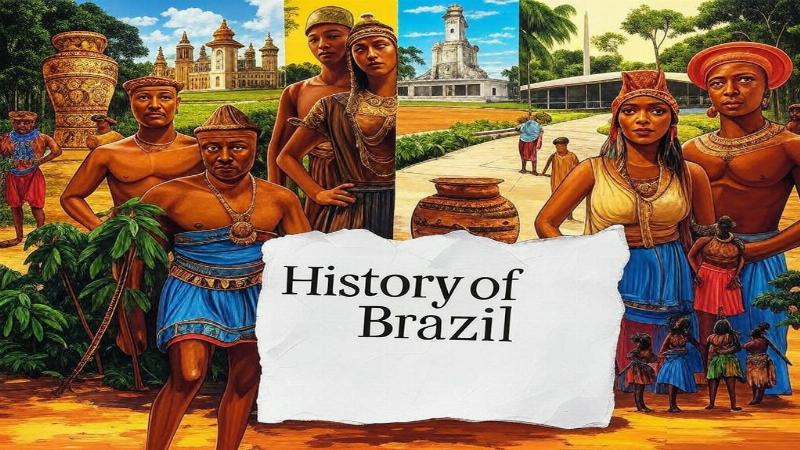Place for ads

Brazil, the largest nation in South America, is a vibrant land where rainforests, rivers, and rhythms tell a sprawling tale. Covering 8,515,767 square kilometers, it stretches across half the continent, bordered by every South American country except Chile and Ecuador. Known today for its Carnival, soccer, and Amazon wonders, Brazil’s history is a rich blend of indigenous heritage, colonial ambition, and modern dynamism. In this article, we’ll journey through Brazil’s past, from its earliest inhabitants to its contemporary identity, uncovering the milestones that have shaped this captivating giant.
Brazil’s human story begins around 12,000 BCE, when hunter-gatherers crossed from Siberia via the Bering Strait, reaching South America. Rock art at Pedra Furada in Piauí—dated to 10,000 BCE—shows hunting scenes, while Serra da Capivara’s ceramics hint at early settlement. These Paleo-Indians thrived in the Amazon and savannas.
By 1000 BCE, semi-nomadic tribes like the Tupí and Guaraní emerged, farming manioc and fishing rivers. Marajoara culture on Marajó Island (400–1400 CE) left intricate pottery, suggesting complex societies—burial urns reveal a population of thousands. Over 2,000 tribes, speaking 1,000 languages, dotted Brazil by 1500 CE.
On April 22, 1500, Portuguese navigator Pedro Álvares Cabral landed
Place for ads
In 1532, Martim Afonso de Sousa founded São Vicente, Brazil’s first permanent settlement. Sugar plantations bloomed along the northeast coast, driving Portugal’s economy. By 1549, Tomé de Sousa established Salvador as the capital, cementing Brazil as a colony under a governor-general system.
Sugar made Brazil Portugal’s treasure—engenhos (mills) in Pernambuco and Bahia churned out wealth by the 1600s. Enslaved Africans, brought from Angola and West Africa, fueled it—over 4 million arrived by 1850, more than any New World colony. Jesuit missions, like those in São Paulo, clashed with planters over indigenous enslavement.
Dutch invasions (1624–1654) seized Recife, but Portugal reclaimed it. The 1695 Palmares rebellion—led by Zumbi, a quilombo (runaway slave) leader—defied colonial rule until its fall. Gold strikes in Minas Gerais shifted focus south, birthing Ouro Preto and moving the capital to Rio de Janeiro in 1763.
Napoleon’s 1808 invasion of Portugal drove King João VI to Rio, making Brazil the empire’s seat—unique among colonies. Ports opened, and Rio modernized with schools and banks. João returned to Lisbon in 1821, leaving son Pedro I, who declared independence on September 7, 1822, at Ipiranga, becoming emperor.
The Empire of Brazil (1822–1889) faced turmoil—Pedro I abdicated in 1831 for Pedro II, who ruled from age 14. Coffee boomed in São Paulo, replacing sugar, while the 1865–1870 Paraguayan War drained resources. Slavery’s 1888 abolition under Princess Isabel ended the monarchy’s support—elites toppled Pedro II in 1889, birthing a republic.
The First Republic (1889–1930) rode coffee’s wave—Brazil supplied 75% of the world’s beans by 1900. São Paulo’s barons dominated, but rural unrest—like the 1897 Canudos War—exposed inequality. European immigrants—Italians, Germans—flocked to the south, shaping cities like Blumenau.
Political instability reigned—coups and revolts marked the era. Getúlio Vargas seized power in 1930 after a coffee price crash, launching the Estado Novo (1937–1945)—a dictatorship blending nationalism and labor reforms. World War II saw Brazil join the Allies, sending troops to Italy and cementing U.S. ties.
Democracy returned in 1945—Vargas, ousted, won back power in 1951, only to kill himself in 1954 amid scandal. Juscelino Kubitschek (1956–1961) built Brasília, a futuristic capital opened in 1960, symbolizing progress. The 1964 military coup, backed by the U.S., crushed João Goulart’s reforms, ushering in 21 years of dictatorship.
The military regime (1964–1985) modernized—Amazon highways and hydropower rose—but tortured dissenters like Dilma Rousseff. Economic “miracles” faded by the 1980s, sparking Diretas Já protests. Democracy resumed in 1985 with José Sarney, and the 1988 Constitution sealed civilian rule.
Today, Brazil’s 203 million people make it a global player—Fernando Henrique Cardoso (1995–2003) stabilized the Real, while Luiz Inácio Lula da Silva (2003–2011) lifted millions from poverty. The 2014 World Cup and 2016 Rio Olympics showcased Brazil, but corruption—like the Petrobras scandal—toppled Dilma Rousseff in 2016.
Jair Bolsonaro (2019–2022) polarized Brazil—deforestation soared, COVID-19 killed over 600,000. Lula’s 2022 return aims to heal divides. The Amazon, samba, and favelas define Brazil—its economy blends soy, oil, and tech, though inequality and crime challenge progress.
Brazil’s history is a South American odyssey—from Tupí villages to colonial gold, independence to modern might. Its jungles hum with ancient echoes, its cities pulse with vitality. As Brazil strides forward, its past fuels a legacy of diversity and defiance.
Place for ads